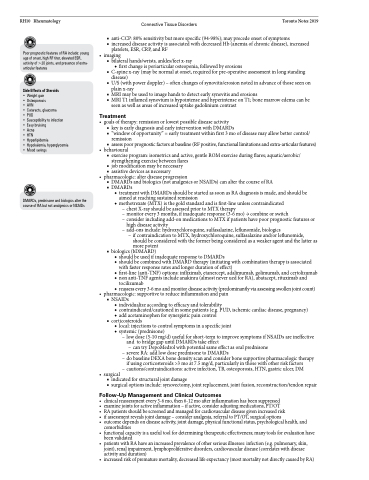Page 1296 - TNFlipTest
P. 1296
RH10 Rheumatology
Connective Tissue Disorders Toronto Notes 2019
■ anti-CCP: 80% sensitivity but more specific (94-98%); may precede onset of symptoms
■ increased disease activity is associated with decreased Hb (anemia of chronic disease), increased
platelets, ESR, CRP, and RF • imaging
■ bilateral hands/wrists, ankles/feet x-ray
◆ first change is periarticular osteopenia, followed by erosions
■ C-spine x-ray (may be normal at onset, required for pre-operative assessment in long standing disease)
■ U/S (with power doppler) – often changes of synovitis/erosion noted in advance of those seen on plain x-ray
■ MRI may be used to image hands to detect early synovitis and erosions
■ MRI T1 inflamed synovium is hypointense and hyperintense on T1; bone marrow edema can be
seen as well as areas of increased uptake gadolinium contrast
Treatment
• goalsoftherapy:remissionorlowestpossiblediseaseactivity
■ key is early diagnosis and early intervention with DMARDs
■ “window of opportunity” = early treatment within first 3 mo of disease may allow better control/
remission
■ assesspoorprognosticfactorsatbaseline(RFpositive,functionallimitationsandextra-articularfeatures)
Poor prognostic features of RA include: young age of onset, high RF titer, elevated ESR, activity of >20 joints, and presence of extra- articular features
Side Effects of Steroids
• Weight gain
• Osteoporosis
• AVN
• Cataracts, glaucoma • PUD
• Susceptibility to infection • Easy bruising
• Acne
• HTN
• Hyperlipidemia
• Hypokalemia, hyperglycemia • Mood swings
DMARDs, prednisone and biologics alter the course of RA but not analgesics or NSAIDs
• behavioural
■ exercise program: isometrics and active, gentle ROM exercise during flares; aquatic/aerobic/
strengthening exercise between flares ■ job modification may be necessary
■ assistive devices as necessary
• pharmacologic:alterdiseaseprogression
■ DMARDs and biologics (not analgesics or NSAIDs) can alter the course of RA ■ DMARDs
◆ treatment with DMARDs should be started as soon as RA diagnosis is made, and should be aimed at reaching sustained remission
◆ methotrexate (MTX) is the gold standard and is first-line unless contraindicated
– chest X-ray should be assessed prior to MTX therapy
– monitor every 3 months, if inadequate response (3-6 mo) → combine or switch
– consider including add-on medications to MTX if patients have poor prognostic features or
high disease activity
– add-ons include: hydroxychloroquine, sulfasalazine, leflunomide, biologics
– if contraindication to MTX, hydroxychloroquine, sulfasalazine and/or leflunomide, should be considered with the former being considered as a weaker agent and the latter as more potent
■ biologics (bDMARD)
◆ should be used if inadequate response to DMARDs
◆ should be combined with DMARD therapy (initiating with combination therapy is associated
with faster response rates and longer duration of effect)
◆ first-line (anti-TNF) options: infliximab, etanercept, adalimumab, golimumab, and certolizumab
◆ non anti-TNF agents include anakinra (almost never ued for RA), abatacept, rituximab and
tocilizumab
◆ reassessevery3-6moandmonitordiseaseactivity(predominantlyviaassessingswollenjointcount)
• pharmacologic:supportivetoreduceinflammationandpain ■ NSAIDs
◆ individualize according to efficacy and tolerability
◆ contraindicated/cautioned in some patients (e.g. PUD, ischemic cardiac disease, pregnancy) ◆ add acetaminophen for synergistic pain control
■ corticosteroids
◆ local: injections to control symptoms in a specific joint ◆ systemic (prednisone)
– low dose (5-10 mg/d) useful for short-term to improve symptoms if NSAIDs are ineffective and to bridge gap until DMARDs take effect
– can try DepoMedrol with potential same effect as oral prednisone
– severe RA: add low dose prednisone to DMARDs
– do baseline DEXA bone density scan and consider bone supportive pharmacologic therapy
if using corticosteroids >3 mo at 7.5 mg/d, particularly in those with other risk factors • surgical – cautions/contraindications: active infection, TB, osteoporosis, HTN, gastric ulcer, DM
■ indicated for structural joint damage
■ surgical options include: synovectomy, joint replacement, joint fusion, reconstruction/tendon repair
Follow-Up Management and Clinical Outcomes
• clinicalreassessmentevery3-6mo,then6-12moafterinflammationhasbeensuppressed
• examinejointsforactiveinflammation–ifactive,consideradjustingmedications,PT/OT
• RApatientsshouldbescreenedandmanagedforcardiovasculardiseasegivenincreasedrisk
• ifassessmentrevealsjointdamage–consideranalgesia,referraltoPT/OT,surgicaloptions
• outcomedependsondiseaseactivity,jointdamage,physicalfunctionalstatus,psychologicalhealth,and
comorbidities
• functionalcapacityisausefultoolfordeterminingtherapeuticeffectiveness;manytoolsforevaluationhave
been validated
• patientswithRAhaveanincreasedprevalenceofotherseriousillnesses:infection(e.g.pulmonary,skin,
joint), renal impairment, lymphoproliferative disorders, cardiovascular disease (correlates with disease
activity and duration)
• increasedriskofprematuremortality,decreasedlifeexpectancy(mostmortalitynotdirectlycausedbyRA)


